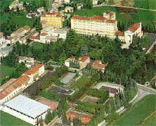
The recipe seems straightforward: dough, tomato sauce, mozzarella, whatever else one desires. Stretch out the dough, pile it all on, stick it in the oven. Simple, right?
Not according to Gemmato Saverio, the owner of Pizzeria Cornaro in upscale Asolo. And he’s the ultimate authority: he’s from Southern Italy, the home of the pizza. Creating a decked-out flatbread that deserves the name “pizza” is an art form, like professional Riverdance or singing a Rossini aria. Making a real pizza, Saverio-style, requires an up-to-date weather forecast, a brick oven and toned wrist muscles.
I had only one of these things at my disposal—the brick oven—for my brief foray into the pizza-making world on this warm night in mid-October in Saverio’s cramped downstairs kitchen, but the chef didn’t seem to mind. He had the weather forecast at the ready, and he’d already made a dozen little mounds of dough that corresponded perfectly with the temperature outside. Our travel writing class, the professors and their families all awaited the opportunity to impress Saverio with our cooking skills.
“The main ingredients are the dough and the water, because the amounts change depending on the weather,” Marta translated to us Americans as Saverio spoke lightning-fast Italian. “If it’s cold, use more dough and hot water; if it’s hot, use less dough and cold water.”
So it’s not just an art, I thought; it’s also a science. And as I held the little 200-gram ball of grain-flecked white dough in my hand, I understood why. Because Saverio had combined just the right amount of water with flour and yeast and salt, it was soft to the touch, yet so elastic that only an Exacto Knife could break through. Yikes. I wondered how long it would take to digest when it came out of the oven and into my mouth.
I was slightly intimidated when I saw Saverio flatten the pizza dough against the marble kitchen countertop. His hands moved at top speed, so fast that you could actually hear them swooshing in the air in time with the gentle swish-swish of the dough turning clockwise against the marble. Flattening “takes only 10 to 12 seconds per pizza,” he told us.
But it took me at least five minutes, what with all the giggling and the preventing the dough from sliding to the floor and the clumsy flattening of the uneven sections. Saverio shouted out one-word Italian phrases at random, apparently assuming we would understand and improve our technique if we listened. “Aspetta…più veloce…bravissima!” I frowned, but said “grazie (thank you)” and hoped it was the correct reply.
In several metal compartments above the counter are all the pizza toppings a girl could want: marinara, mozzarella, tomato, onion, mushroom, artichoke and zucchini. I threw them all on, taking care to skimp on the mozzarella after Saverio tells us that “the pizza doesn’t cook right if there’s too much cheese.” But then he sees how little I’ve spread on the pizza and asks, “Un po’ più? (A little more?)” I nod, and he scoops up twice the cheese pieces I’d put on the pizza in the first place. In Italy, “a little” means “a lot”.
Saverio shoos us away from his kitchen when it’s time to shovel the pizzas into the oven, and he brandishes a terrifying six-foot-long metal wand to carefully deposit the pies deep within the bowels of the brick oven, where there’s a large, ash-laden fire waiting to warm them.
When I sit down at an upstairs table to enjoy the result of my hard work exactly seven minutes later, I marvel not at the art and science of pizza making, but with the unusually close contact an Italian chef has with the food when creating the perfect pizza. Usually there are knives, rolling pins or electric mixers between a cook and his food; with pizza, there is no barrier. The whole process, then, is less mechanical and more personal. But when Saverio smooshes his hands into the dough, when he pulls at it on the countertop, when he digs into all his bowls and metal compartments for the toppings, describing the science of proportion and the art of combinations, he neglects to mention the most important ingredient in his pizzas: love.

No comments:
Post a Comment